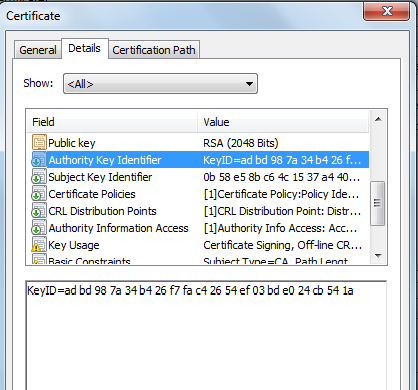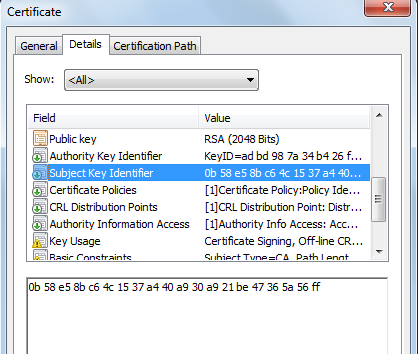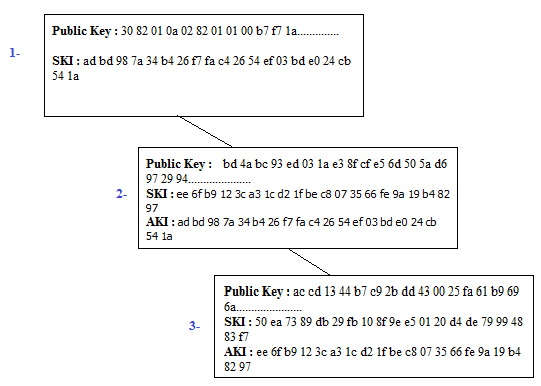AKI and SKI Extension
The authority key identifier (AKI) is an X.509 v3 certificate extension. It contains a key identifier which is derived from the public key in the issuer certificate.

In the above certificate, authority key identifier (AKI) is selected.
Subject key identifier (SKI) is also an X.509 v3 certificate extension. It also contains a key identifier which is derived from the public key in the subject certificate.

In the above certificate, subject key identifier (SKI) is selected.
The key identifier in AKI and SKI is SHA-1 hash of the issuer and subject public key respectively.
The AKI and SKI values are mainly used in certificate path construction in order to identify the right issuer certificate.

In the above diagram, there is a simple hierarchical PKI. The certificate at 1) is a Root CA which is a self signed certificate. Self signed Root CA certificate signs itself with its own private key. According to the above definition, key identifier in AKI is derived from the issuer public key while key identifier in SKI is derived from the subject public key. In the self signed case, the subject and issuer is the same so the AKI and SKI would be the same. According to RFC 5280, the AKI can be omitted in the self signed certificates.
The certificate at 2) is an intermediate certificate, The certificate at 2) is signed using the private key of the issuer certificate 1). The AKI in certificate 2) is derived from the issuer certificate public key i.e. from certificate 1). The SKI in certificate 2) is derived from the subject certificate public key i.e. from certificate 2). In this case, the value of AKI at certificate 2) would be equal to SKI value of the certificate 1).
The same process would be followed for the certificate 3).
According to RFC 5280, the AKI contains the keyIdentifier, authorityCertIssuer and authorityCertSerialNumber. These two combinations can be used to identify the issuer certificate i.e. either from the keyIdentifier or from the authorityCertIssuer and authorityCertSerialNumber. In AKI, keyIdentifier is commonly used way to identify the issuer certificate.
There are three ways to find the issuer certificate :
- Comparing AKI in the subject certificate with the SKI in the issuer certificate. If both are equal then it means that the issuer certificate private key was used to sign the subject certificate
- Verify signature of the subject certificate using the issuer certificate public key. If signature is verified then it means that the issuer certificate private key was used to sign the subject certificate
- Name chaining i.e. compare the issuer DN in the subject certificate with the subject DN in the issuer certificate. Name chaining do not provide solid proof because there could be multiple CA certificates with the same subject DN